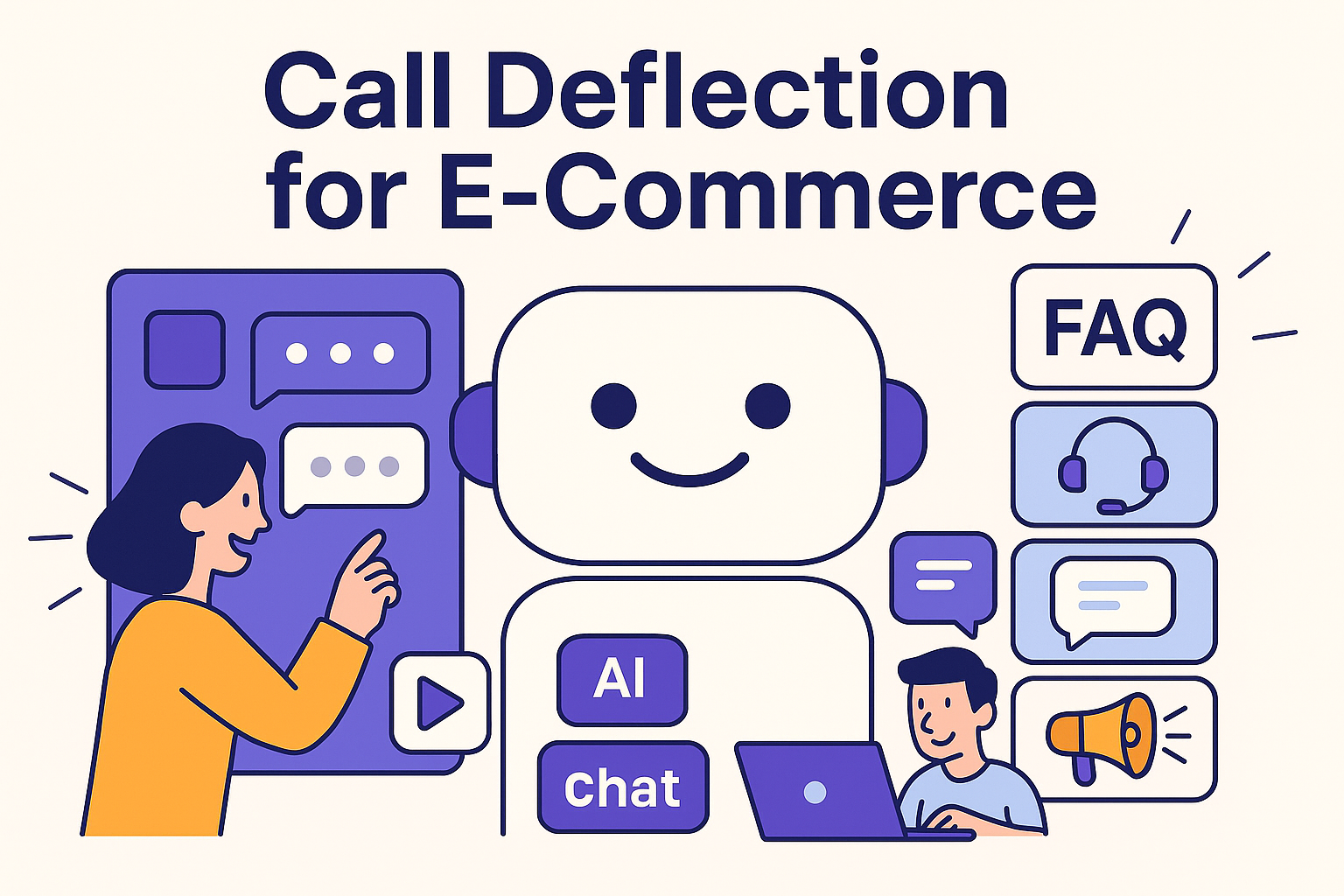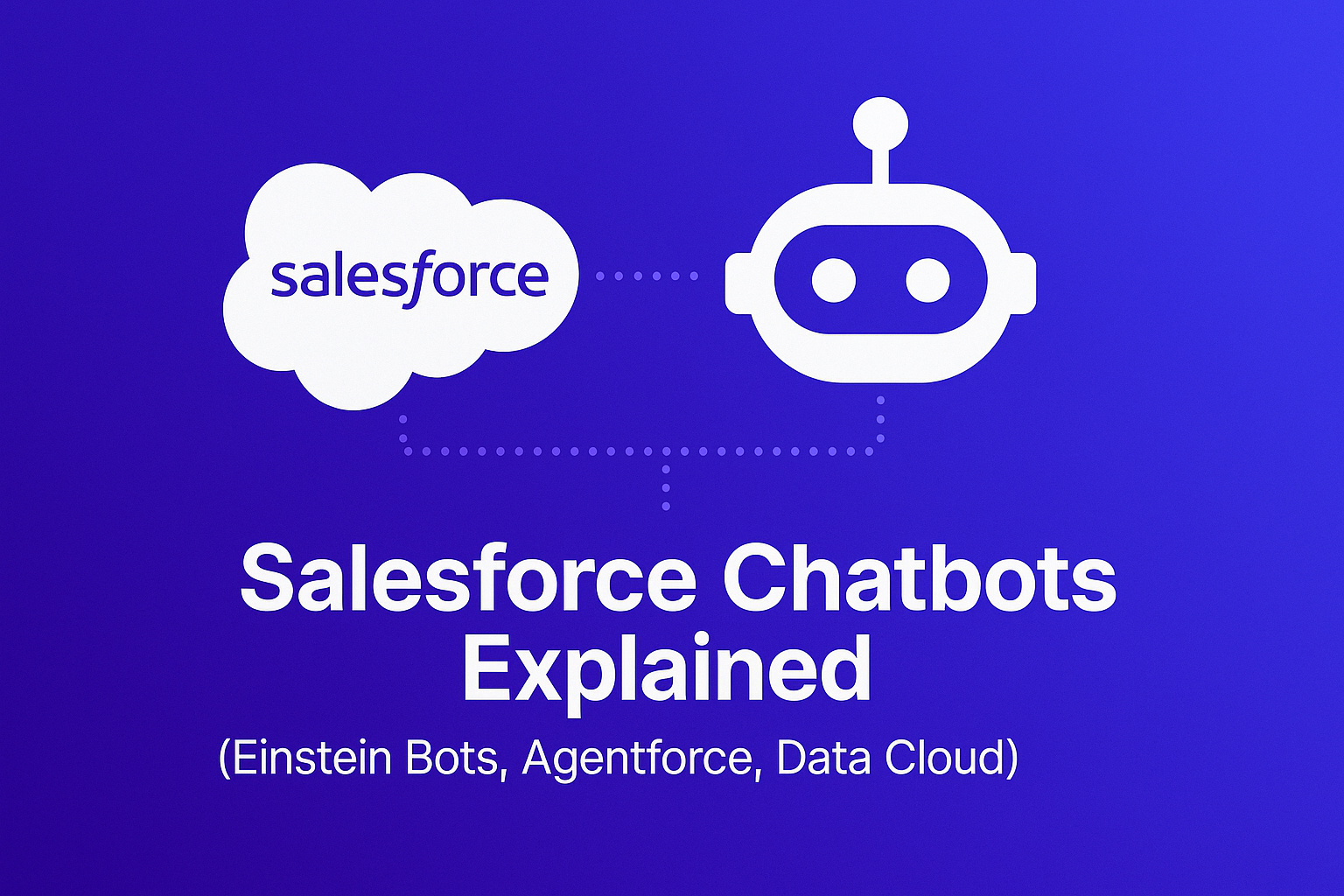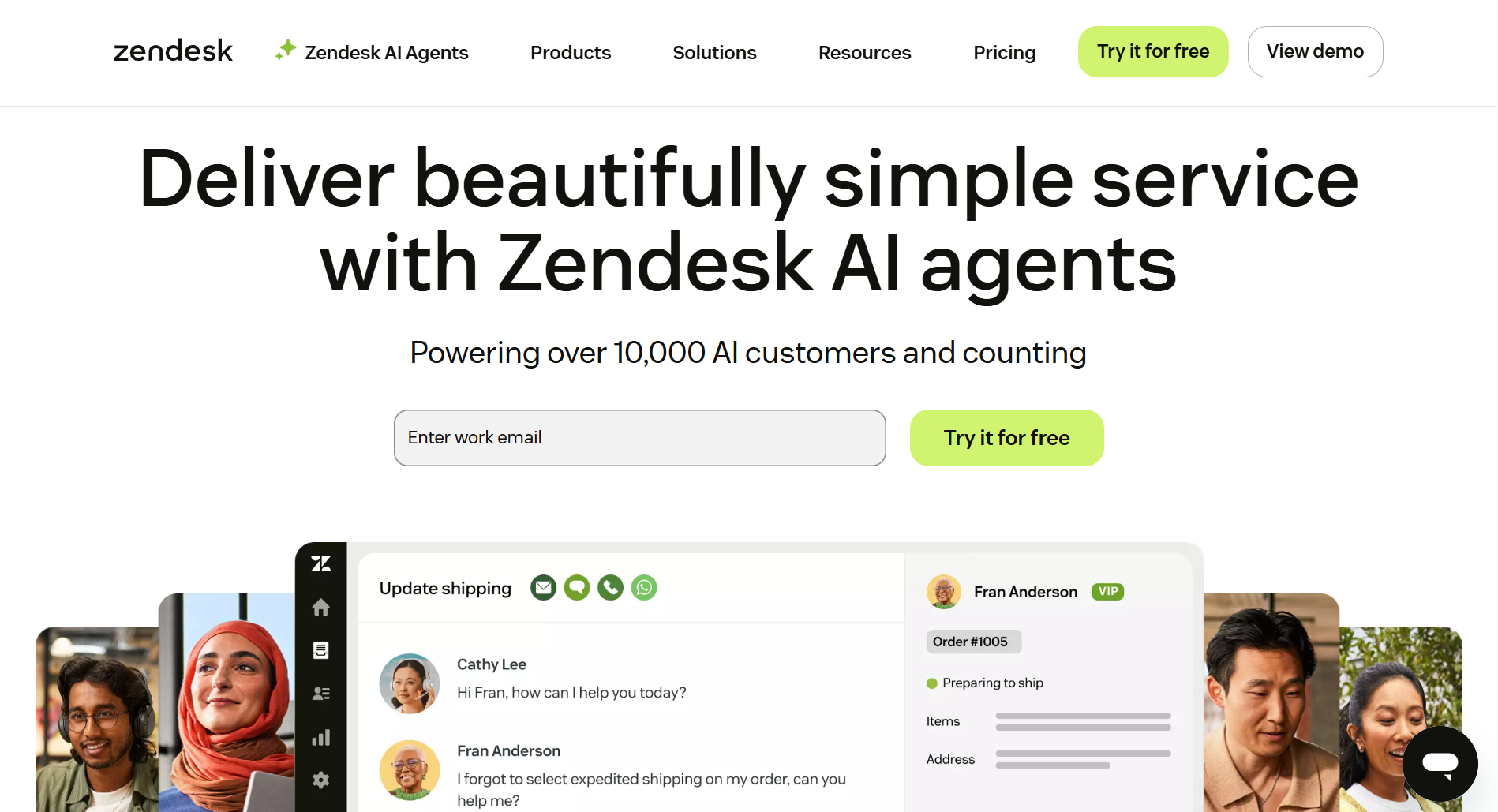AI in E-Commerce: 7 Real Use Cases with Examples (2025)

Let’s be honest: you’re not reading this article because you’re fascinated by neural networks and crave to know how they work.
You’re here because you want to know if it can actually boost your profit or if it is just another expense with a smarter name.
That’s a fair question, especially when most conversations around AI sound like they were written by someone trying to impress a venture capitalist.
In the world of e-commerce, AI isn’t some abstract future. It’s already changing how the smartest shops handle support, returns, inventory, and customer experience, not by replacing people, but by helping them stop wasting time, money, and margin on tasks that software can do faster and smarter.
This article isn’t about what AI might do someday. It’s about what it’s already doing, right now, to improve operational efficiency and drive profit in businesses like yours.
And if it’s working for them, it can work for you. You just need to know where to start.
This article isn’t about theory. It’s a field guide to 7 real-world use cases where AI is already doing the one thing that actually matters: driving profit.
👇Quick Navigation: 7 Real AI Use Cases That Boost Profit in E-commerce
- AI Customer Support vs. Manual Tickets
- Smart Returns vs. Manual Processing
- AI Inventory Forecasting vs. Guessing
- Multilingual AI Chatbots vs. One-Language Support
- Dynamic Pricing vs. Spreadsheet Updates
- AI Copywriting vs. Manual Product Descriptions
- Product Recommendations in Chat vs. Static UX
Why AI in E-Commerce Can’t Wait
Imagine this:
Your customer gets their order late. They try to contact support, but all they get is a “We’ll get back to you” message. They return the item. The process takes 12 days. They leave a one-star review and never come back.
Now imagine this happens 1,300 times this month. That’s not a blip. That’s your margin walking out the door.
Meanwhile, your competitor?
Their AI spots the delay before the customer does. Their chatbot, not a clunky widget, but an AI-powered assistant, handles the inquiry instantly, in their native language. The return is frictionless. They even recommend a better alternative.
And the result? One lost sale becomes two new ones and a five-star review.
This isn’t science fiction. It’s just machine learning, natural language processing, and a bit of smart customer experience design. And it’s happening now in real ecommerce operations, at real scale.
Today, the question isn’t about whether AI belongs in your business. It’s about how much profit you’re losing by not using it right.
We’ve collected 7 use cases where AI is already solving real problems: reducing returns, speeding up content, optimizing pricing, and turning support into a revenue stream.
These aren’t lab tests. These are proven, in-the-wild strategies from ecommerce brands who’ve stopped talking about AI and started profiting from it.
Let’s start with the one you’ll wish you’d implemented six months ago.
1. Customer Support That Converts vs. Support That Costs
Let’s talk about the difference between two support teams. Both work in e-commerce. Both get 2,000+ tickets a week. But one is burning cash, and the other is driving conversions.
Team A still treats support as a necessary evil.
Every “Is this in stock?” or “Do you ship to Italy?” gets routed to a human. It takes hours to respond. Sometimes, a ticket slips through. The customer experience suffers. Customer satisfaction tanks. And the only metric going up? Cost per resolution.
Team B handles things differently.
When a customer asks about return policy or product fit, their AI chatbot, powered by something like AMIO, replies instantly and deals with over 70% of inquiries that don’t need a human touch. It doesn’t guess, it draws answers from structured product data, understands inventory levels, and speaks the same language as the buyer (literally and figuratively).
So when a customer says, “Which size should I pick for wide feet?”
Team A forwards it to the support queue.
Team B’s bot, powered by something like AMIO’s AI chatbot, answers instantly, recommends the right variant, highlights the fit notes, and links directly to the product without the customer ever leaving the chat.
Boom. Conversion.
And here’s the kicker: Team B’s agents aren’t working harder. They’re working smarter because AI handles the repetitive stuff, and the agents, meanwhile, focus on the stuff that actually needs a human brain: complaints, escalations, custom requests, or edge cases.
The difference for team B shows up fast:
- Lower support costs
- Happier customers
- Better customer experience
- Real customer engagement
Support stops being a cost center. It becomes a tool for personalized shopping experiences and, yes, profit.
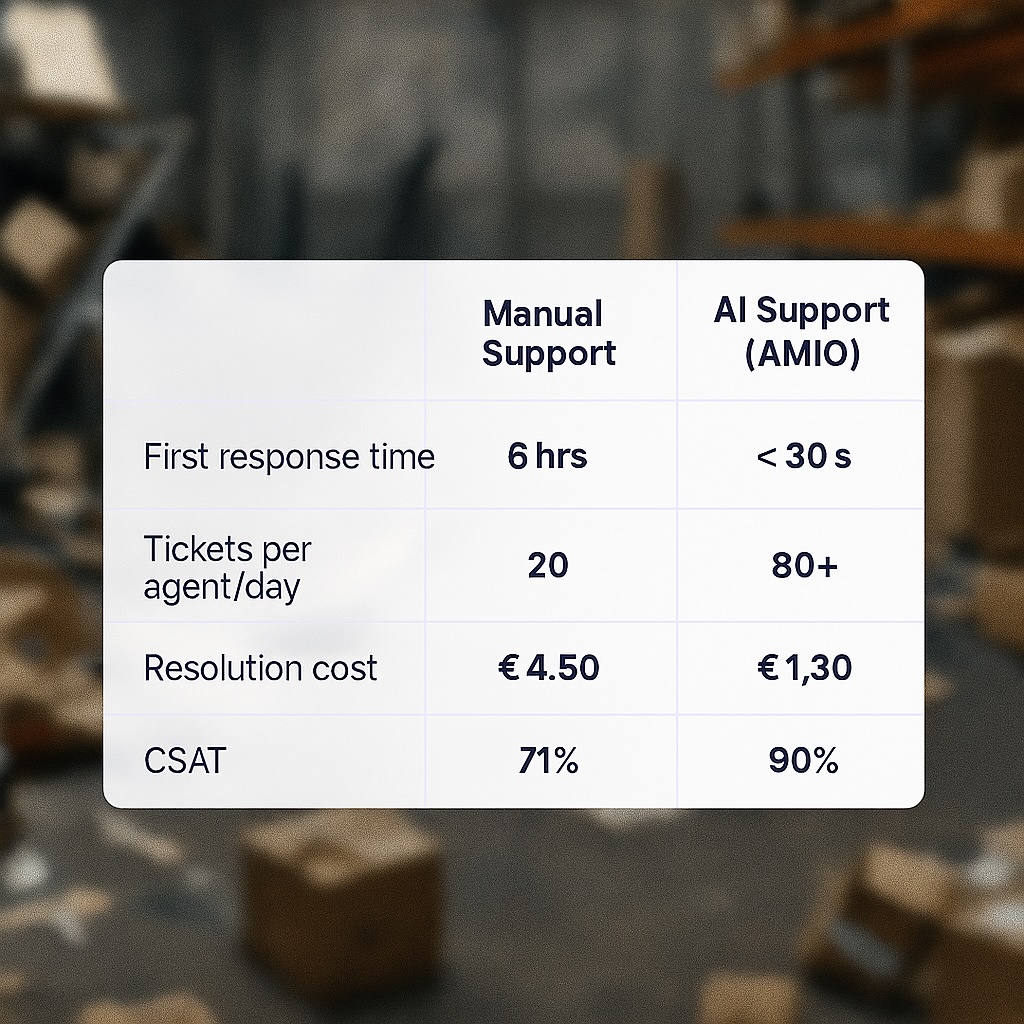
2. Returns That Bleed Margin vs. Returns That Boost Loyalty
Every e-commerce brand deals with returns. But whether they drain your margin or deepen customer loyalty? That’s entirely up to how you handle them.
Let’s say both stores sell the same product. Both get it returned.
Store A handles it manually.
The customer has to write to support, wait for a reply, print a label, and ship it to a warehouse chosen by someone on their third espresso. It lands in the wrong warehouse. Restocking takes forever. The item misses the resale season.
Customer’s annoyed, so customer satisfaction drops. And that €20 shipping fee? Pure margin loss.
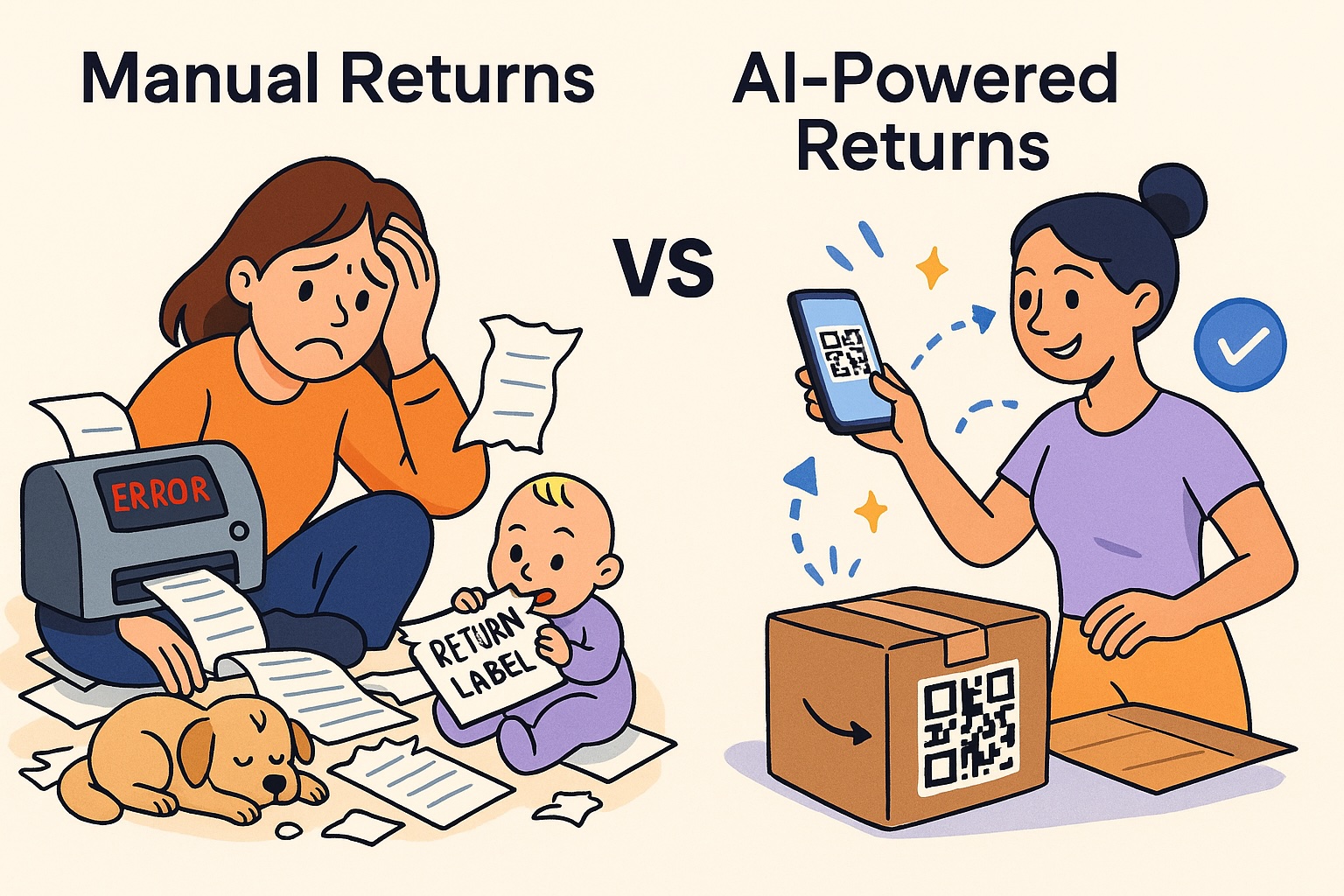
Store B uses AI.
Tools like ReturnGO or Narvar automate the returns process using predictive analytics and resale potential. The system decides the cheapest eligible return route based on inventory levels, location, and how likely the product is to be resold.
And the customer? Gets a clean return management portal with smart options: exchange, store credit, or fast refund. No emails. No rage-clicking.
The impact for store B is real:
- Lower logistics cost per return
- Higher customer retention
- Better customer experience that doesn’t end at the “Buy” button
Also? It saves money. A lot.
The average cost to process a return is between €20 and €40, meaning even modest automation could save up to €20 per return (Ingrid Returns Optimization Report)
And if you think €20 per return doesn’t matter, try multiplying that by 30% of your monthly orders. That’s not a detail, that’s your margin.
So the question nowadays isn’t whether returns suck. It’s whether yours still do.
3. Guess-Based Inventory vs. AI-Powered Forecasting
Inventory planning shouldn’t be a guessing game. But at a surprising number of ecommerce businesses, it still is.
Let’s talk about how most ecommerce inventory planning actually works.
Store A plans its inventory the old-fashioned way:
The team meets every quarter, pulls up last year’s sales spreadsheet, and makes their best guess. They look at last year’s sales, toss in some gut feeling, argue over whether that influencer collab really “moved the needle,” and hope the numbers work out.
Spoiler: they don’t. By summer, they’re drowning in leftover spring stock. By Christmas, half their catalog is marked “sold out.” Cash is frozen in unsold inventory. Warehouses are bursting at the seams. Meanwhile, their supply chain team is quietly losing the will to live.
That’s not bad luck. It’s bad planning.
Store B plays a different game.
They’ve got AI-powered tools like Linnworks or Peak.ai to do the hard math, not a tired analyst buried in spreadsheets trying to spot patterns that just aren’t there.
Instead of guessing, they run models that factor in SKU-level sales data, seasonal trends, customer behavior, even external signals like weather or local events, because yes, snow affects boot sales.
The system doesn’t just forecast demand, it recommends the optimal inventory levels to maximize both product availability and margin.
It knows that moving 500 units fast at a lower discount is often better than sitting on 800 for months. It understands your inventory turnover, cash flow, and sales velocity better than any spreadsheet ever could.
Retailers using this kind of AI-powered forecasting don’t just plan better, they cut overstock by 30%, sell faster, and don't lose customers to the dreaded “sorry, we’re out. (Emplicit, 2025 AI Replenishment Report)
Which one sounds like a smarter inventory management strategy?
4. One-Language Support vs. 24/7 Multilingual AI
Let’s say both ecommerce teams sell internationally.
But while one is hiring French-, German- or Italian-speaking agents… the other just hits “on.”
Store A does what most e-commerce retailers do. They cover one or two markets with in-house agents. And the rest? Either wait longer, get auto-translated replies, or bounce altogether.
Hiring multilingual agents is expensive. Training them takes time. And even then, customer satisfaction outside your core market usually lags.
Now imagine Store B. They use an AI-powered chatbot, like the one from AMIO, which instantly detects the customer’s language and replies in context. Not Google Translate-style. Real natural language processing, trained on ecommerce data, powered by ChatGPT under the hood.

Italian shopper asking about sneaker returns? Gets a fluent reply.
Hungarian customer confused about size guides? Gets personalized guidance in Hungarian.
You don't need to grow your headcount to grow your market. With AI-powered chatbot support, you can deliver real customer engagement and consistent customer satisfaction without the need for new hires.
AMIO’s multilingual AI support means ecommerce brands can scale service to 20+ languages without scaling cost. (AMIO)
Take Footshop, for example. They serve customers in over a dozen markets. But their customer care team isn’t twelve times bigger. That’s because AMIO helps them handle a high volume of international inquiries instantly, consistently, and on-brand.
Instead of making customers wait or bounce between agents, their support just… works. The AI understands the question and replies, clearly and instantly, in the customer’s own language.
They create a better customer experience that feels personal, local, and effortless, whether the shopper is in Berlin, Barcelona, or Bangkok. Customers stay engaged longer, customer satisfaction rises, and retention improves.
Their team doesn’t waste time forwarding tickets or copy-pasting translations. Their customers actually get help when they need it. And they remember that.
The result? Customers come back and buy again. And support suddenly becomes one of the best parts of their customer journey, not the worst!
Footshop uses AMIO’s multilingual chatbot to handle customer support across 14 markets without adding new headcount. The result? Support costs dropped by 33% and the ROI landed in just 6 months. (See full Footshop case study)
Sure, English is “the international language.”
Until your French customer wants help… and your reply says: Bonjour. Please hold.
5. Manual Pricing Struggles vs. Real-Time Repricing Engine
Let’s talk pricing. Not in the boardroom strategy sense but in the “Why is this still in stock?” sense.
Store A still handles pricing manually.
→ Download CSV → Filter by slow sellers → Argue over discounts → Update platform manually → Repeat next quarter
Every change goes through a spreadsheet. Every decision involves a Slack thread, a late-night panic, or both. Prices get updated once a week (if that). And when inventory piles up or a competitor drops their price? They notice three days later, and by then, the margin’s gone.
Slow-moving SKUs are left to gather dust and margin leaks. Unnoticed until it’s too late.
Now, meet Store B.
They’re using AI-powered tools like Prisync and Dynamic Yield, built to track customer data, search queries, inventory levels, and competitor pricing in real time. Their machine learning models adjust pricing dynamically, not reactively, and always with margin protection in mind.
Let’s say a certain product has been stuck at 400 units for 3 weeks. Instead of slashing prices across the board, their machine learning model predicts which price point will unlock sell-through while still protecting margin.
Or say a top competitor drops their price. Within minutes, Store B responds, not with panic, but with predictive analytics that weigh in inventory levels, sales velocity, and SKU-level data to decide whether matching is even necessary.

So instead of slashing prices across the board, Store B gets smart:
They offer a personalized discount to returning visitors, tweak pricing only on low-performing SKUs with high stock, and bundle it with another product to lift average order value.
The result?
- Higher inventory turnover
- Fewer dead SKUs
- Dynamic pricing without human bottlenecks
- And yes, more profit per product sold!
Sounds like something only Amazon could pull off? Not anymore. Tools like these are now accessible to mid-sized ecommerce retailers, and yes, even your Shopify or WooCommerce store.
Manual pricing was fine when you had 20 SKUs. But if you’ve got hundreds or thousands, it’s no longer a strategy.
Dynamic pricing helped Amazon lift revenue by 25%. For the rest of us? The average gain is 1–8% (Fetcherr, 2025). If your store does €100k/month, that’s up to €8,000 just from letting AI do the math you’ve been putting off.
Are you really going to bet against that?
6. Copywriting Bottlenecks vs. AI-Generated Product Content at Scale
Every ecommerce brand knows the feeling.
New product drops. New collection. Maybe a new supplier. And someone on your team sighs because it means writing 130 product descriptions. Again.
Store A does it the traditional way.
A product manager pulls data from the PIM. A copywriter spends 20 minutes crafting a description. Then someone else double-checks SEO, someone localizes, and someone panics because the launch was yesterday. Multiply that by 300 SKUs and you get your worst nightmare.
This is why new arrivals sit unpublished for days or go live with placeholder text like “high-quality cotton shirt for everyday use.”
It’s not just boring. It’s bad for SEO, bad for product discovery, and worst of all, it’s obvious to the customer. You promised a personalized shopping experience and gave them a robot’s idea of style.
Store B, on the other hand, knows better.
They use generative AI tools like Shopify Magic, Jasper, or even ChatGPT trained on their own product data, customer preferences, and brand voice to generate hundreds of SEO-optimized, localized, conversion-friendly product descriptions in hours. Not weeks.
Now, when they launch a new item:
- The AI pulls in SKU-level data: size, material, use case
- Cross-references search queries and seasonal trends
- Adds details from customer feedback or ratings and reviews
- Writes optimized copy for every ecommerce site, in every needed language
- And formats for SEO, automatically
They don’t just get 1 generic description. They get:
- 3 versions: for web, marketplace, email
- 5 localizations: English, German, French, etc.
Need 80 variations for seasonal trends? Done.
Want personalized product recommendations with embedded keywords for visual search and customer behavior triggers? Also done.
Need it in 5 languages by Monday? You guessed it: already live.
And because the AI pulls from real-time inventory, search queries, and even ratings and reviews, the result isn’t generic fluff; it’s content that sells
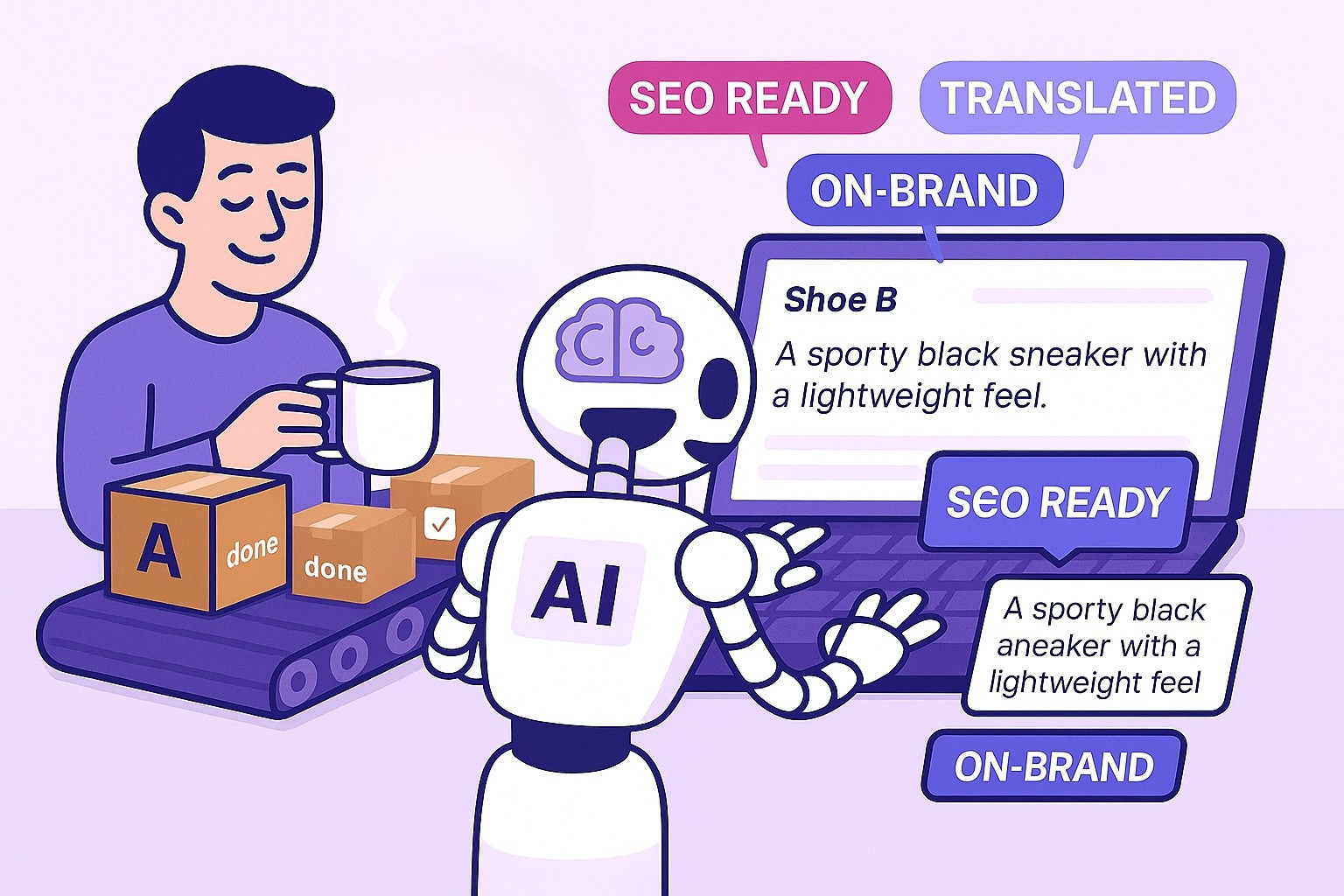
The outcome?
- Faster go-to-market for every new launch
- Consistent, on-brand copy across all eCommerce websites
- Improved product discovery via smarter content creation
- And yes. Actual time savings for the team
JD.com’s Automatic Product Copywriting system produced 2.5 million product descriptions, boosting click-through rate by 4.22% and conversion rate by 3.61% year-over-year (Arxiv, 2021)
So what’s your product copy costing you?
7. Static Sites vs. Scripted Bots vs. Smart Recommendations in Chat
Finding the right product shouldn’t feel like filling out a tax form. But on most e-commerce sites, it still does.
Store A has no chatbot.
Just a search bar, some filters, and a “Customers also bought” widget that’s about as helpful as a shrug. Want to buy something for wide feet, or for someone who likes minimalist style? Good luck.
The customer journey is static, impersonal, and entirely up to the shopper to figure out.
Store B has a chatbot, but the kind that only knows five phrases.
It greets the customer, maybe shares a discount, and then hits a wall. It can’t ask about preferences. It doesn’t understand customer behavior, product categories, or what makes one item more relevant than another. It’s not connected to SKU-level data, doesn’t personalize anything, it just follows a script.
Now look at Store C.
They’ve equipped their site with an AI-powered chatbot like AMIO, and suddenly, the experience shifts.
The moment the chat opens, the assistant starts asking smart, context-aware questions:
“Are you shopping for yourself or a gift?”
“Looking for something new in your usual size?”
“Prefer minimalist or colorful styles?”
Behind the scenes, the chatbot pulls from structured product data and real-time inventory levels. It’s not guessing, it’s using machine learning models to tailor personalized product recommendations for each customer.
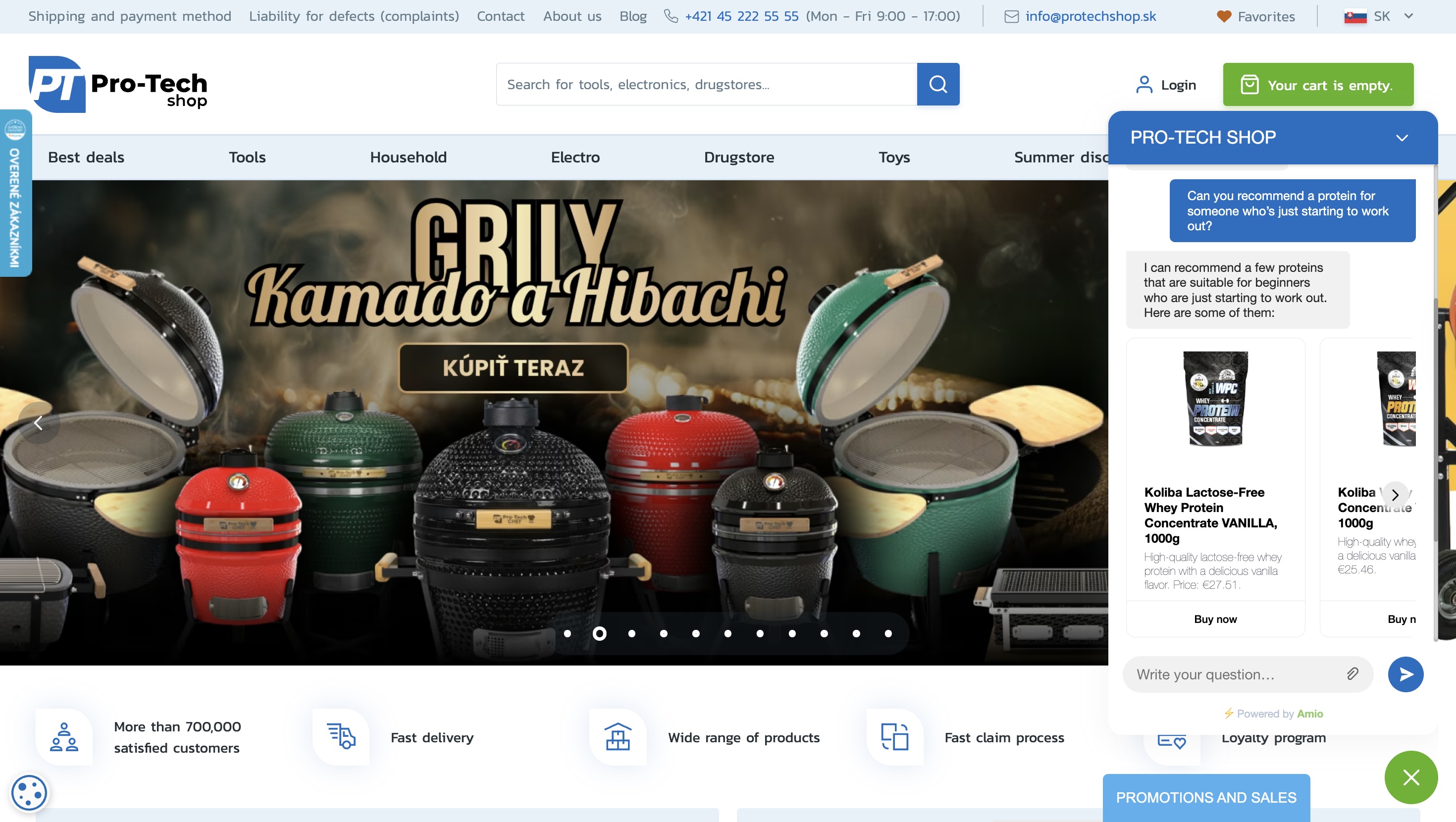
Even better, the team behind Store C can configure how this works:
- Decide which products to prioritize
- Control how many results the chatbot suggests
- Set rules for different user interactions, like when to ask follow-up questions or suggest alternatives
Your chatbot isn’t just answering questions. It’s quadrupling your conversions. Shoppers who engage with AI chatbots convert at 12.3%, compared to just 3.1% without. (Hellorep.ai, 2025)
And it works in any language. Thanks to AMIO’s use of ChatGPT and natural language processing, the assistant can guide shoppers seamlessly whether they’re in Prague or Palermo. It’s like having a personal shopper in the chat, but automated.
Europcar, for example, uses this setup to support customers 24/7 and guides visitors to the right car, which helped boost lead collection by 21%. (See full Europcar's case study)
The result?
- More conversions.
- Better customer engagement.
- A smoother, smarter personalized shopping experience without the manual work.
So if your site still expects customers to find the perfect product on their own…
…how long before they stop trying?
If these use cases weren’t enough… And you’re hungry for more ways AI can boost conversions, cut costs, and save your team’s sanity, don’t miss this guide: 👉Top 8 AI Use Cases in E-commerce (with benefits + real examples)
Doing Nothing Is Now the Riskiest Move
Let’s get real. AI isn’t some shiny innovation waiting on your 2026 roadmap. It’s already boosting margins, lifting retention, and automating the kinds of manual tasks that have quietly been draining your team’s time and budget.
AI-powered recommendations, chatbots, dynamic pricing engines, and automated product content are no longer some enterprise luxury. They’re already live on thousands of eCommerce websites. And not just Amazon-scale giants.
We’re talking mid-sized ecommerce shops. Lifestyle brands. Retailers with small support teams but a big ambition.
The truth is:
- You don’t need to hire a data scientist.
- You don’t need to replace your team.
- And no, you don’t need a 12-month transformation project or a new headcount to get started.
Start with just one use case:
- Automate repetitive support with an AI-powered chatbot
- Deploy predictive analytics for smarter inventory management
- Launch AI-generated product descriptions that actually convert
- Use dynamic pricing to protect margin and move slow stock
Each of these can create a measurable impact in days, not quarters.
E-commerce retailers using even basic AI technologies are already seeing better customer satisfaction, smoother personalized shopping experiences, and lower cost-per-conversion. And the gap between brands that move and those that stall? It’s growing fast.
Nobody’s asking you to “AI your entire business.”
But in 2025, ignoring tools that improve customer experience, reduce manual work, and protect margin? That’s the real gamble.
Doing nothing costs more than trying. Let AMIO show you exactly where you can reduce costs, lift conversions, and improve your customer experience — and you can launch in days. 👉 [Book FREE Demo]
Book a 30-minute session where we will find out how AI bot can help you decrease call center costs, increase online conversion, and improve customer experience.
Book a demo